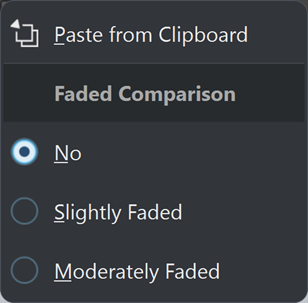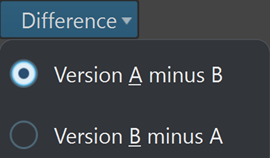Spectral Profile Tab
The Spectral Profile tab allows you to set the parameters for the frequency-related Visual Analysis and to specify how to display the results.
-
To access the Spectral Profile tab, do one of the following:
-
Select .
-
Click the Analyze tab at the top of the Audio Editor or the Audio Montage window, and select Visual Analysis.
-

Upper Left Section

- Average Frequency
-
Activates/Deactivates the visual representation of the analysis results by displaying the average frequency values as a curve.
The Color button to the right of the menu allows you to set a unique color for the curve.
- Play

-
Exclusively plays all hotspots in a linear sequence. To enable you to clearly distinguish the hotspots from each other, one second of silence is automatically inserted prior to each of them. Furthermore, any preroll and postroll settings, as specified on the transport bar, are applied.
In the Audio Montage window, hotspot playback is limited to the active clip.
- Hotspots
-
Allows you to choose which hotspots to display.
-
No Hotspots suppresses the display of hotspots.
-
Lowest Frequency Averages exclusively displays hotspots for the lowest average frequencies.
-
Highest Frequency Averages exclusively displays hotspots for the highest average frequencies.
-
Both Lowest and Highest Frequency Averages displays hotspots for both the lowest and the highest average frequencies.
The Spectral Average Balance menu to the right of the Hotspots menu allows you to display the hotspots Per Channel, Per Channel Cluster, or as a Balance Curve. In addition to this, you can choose to display the average spectral values for a channel, for a channel cluster, or for the balance.
-
- Variable Color (not available for Balance and Difference Curves)
-
With this option activated, you can define colors for frequencies on the curves via the slider below. This makes it easier to compare curves and to identify regions with a particularly low or high brightness.
You can choose from the following options:
-
To add a color, right-click on the color bar, and select Create Color Handle Here.
-
To modify the color gradient, click and drag one of the color handles above the color bar.
-
To edit the color of a color handle, right-click the color handle, and select Edit Color, which opens the Color Selection window.
-
To edit the frequency that the color represents, right-click on a color handle, select Edit Frequency, and enter a numeric value for the frequency.
-
To delete a color handle, right-click on it, and select Delete.
-
- Preset
-
Allows you to save and organize presets.
Upper Right Section

- Difference Range
-
Serves as a vertical zooming tool and indicates the relation between the range of the display and the frequencies below and above the axis.
The lower the value, the more the display zooms in on the disparities.
- Hotspot Number
-
Limits the number of hotspots to be displayed and selects the highest ones only.
For example, setting the value to 1 results in exclusively displaying the brightest section. Setting the value to 2 displays the two brightest sections, and so on.
- Hotspot Spacing
-
Controls the distance between hotspots, to prevent them from being displayed too close to each other.
For example, setting the value to 1 s ensures that there is at least a one-second space between the hotspots.
TipMake sure you set the value low enough, so that the desired number of hotspots is displayed.
Lower Section

You can display the results of the analysis for Version A or for Version B or both of them at the same time.
-
Analyze initiates the analysis of the spectral attributes of the active, unprocessed audio file in the Audio Editor or the selected, unprocessed clips in the Audio Montage window.
As a result, a spectral profile is generated that is labeled as Version A.
Version A allows you to display frequency-related hotspots, values, and curves for unrendered audio files or clips.
-
Analyze Rendering starts the analysis with processing applied; that is, as if the audio file or clips were rendered, and generates a spectral profile labeled as Version B.
NoteFor audio files, the analysis is based on the Master Section plug-ins.
For clips in an audio montage, the analysis encompasses any processing, including clip effects, track effects, output effects, and the Master Section plug-ins.
As a consequence, the more plug-ins and effects you add, the more time it takes to complete the analysis.
-
Version B allows you to display frequency-related hotspots, values, and curves for rendered audio files or clips.
You can access further options by clicking the arrow in the lower right corner of the Version A and/or Version B buttons:

|

|
-
-
Copy to Clipboard for Version A and Paste from Clipboard for Version B allow you to save the analysis results, so that you can access and compare them with each other or with another audio file at a later point in time.
-
Faded Comparison
When comparing Version A to Version B, checking No prevents the curves for the selected version from being faded. However, fading the display for one version can make it easier to distinguish the curves for Version A and Version B from each other. Slightly Faded sets them to a minor level of transparency, while Moderately Faded further reduces the opacity of the curves for the selected version.
TipTo reduce the opacity of the waveform display, in addition to or instead of fading the curves, choose one of the options from the Dimmed Waveform menu.
-
-
Difference displays a curve that represents the results of a comparison between Version A and Version B.

You can choose from the following options by clicking the arrow in the lower right corner of the Difference button:
-
Version A minus B subtracts the analysis results for Version B from Version A and displays the difference.
-
Version B minus A subtracts the analysis results for Version A from Version B and displays the difference.
-
-
In the Dimmed Waveform menu, when comparing Version A to Version B, checking No prevents the curves for the selected version from being faded. However, fading the display for one version can make it easier to distinguish the curves for Version A and Version B from each other. Slightly Faded sets them to a minor level of transparency, while Moderately Faded and Very Faded further reduce the opacity of the curves for the selected version.
-
Curve Smoothing displays smoother curves, which may, however, be slightly inaccurate, due to extrapolation and interpolation between quantized values.
Therefore, if precise values and accurate quantization of curves are your priority, we recommend that you deactivate this option.
-
With Auto-Update activated, WaveLab Pro automatically performs the analysis again, as soon as any audio files have been modified.
NoteIf this option is deactivated, spectral profiles are automatically deleted after modifying the audio material.
We recommend that you delete the analysis results as soon as you do not need the spectral profiles any more, as they consume a significant amount of memory. To do so, click the trash can button to the right of the Difference button.